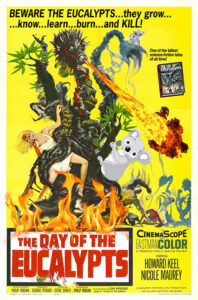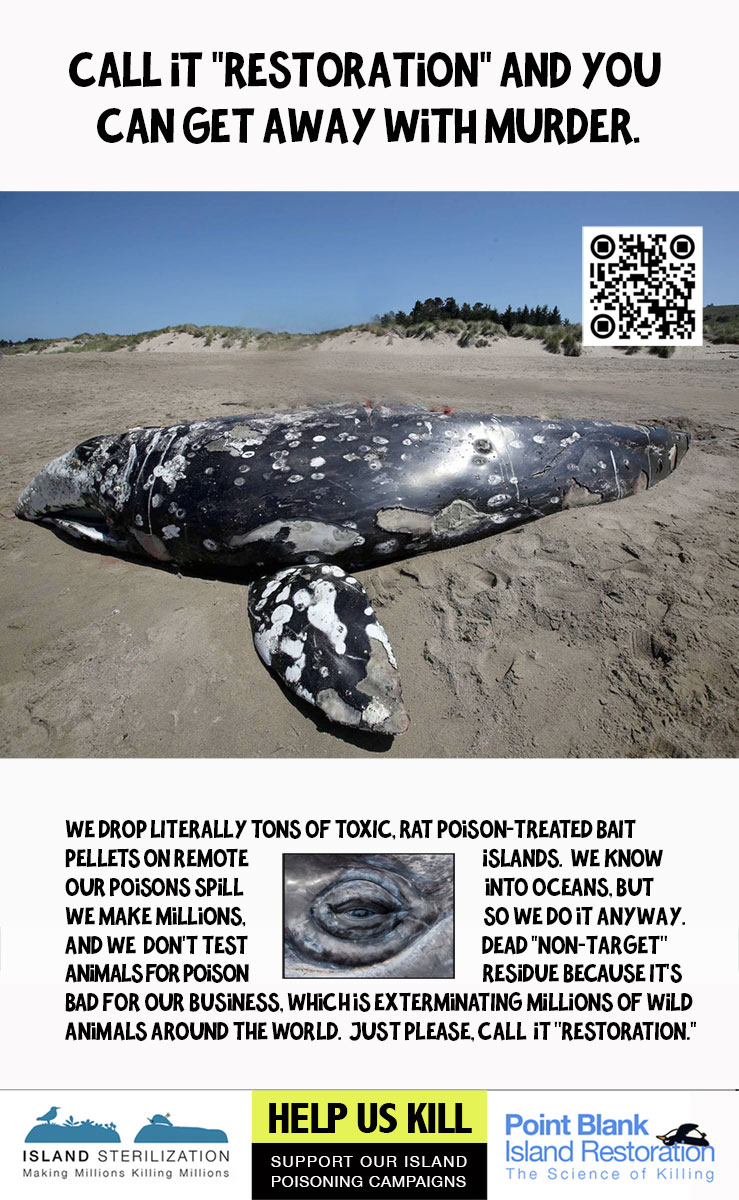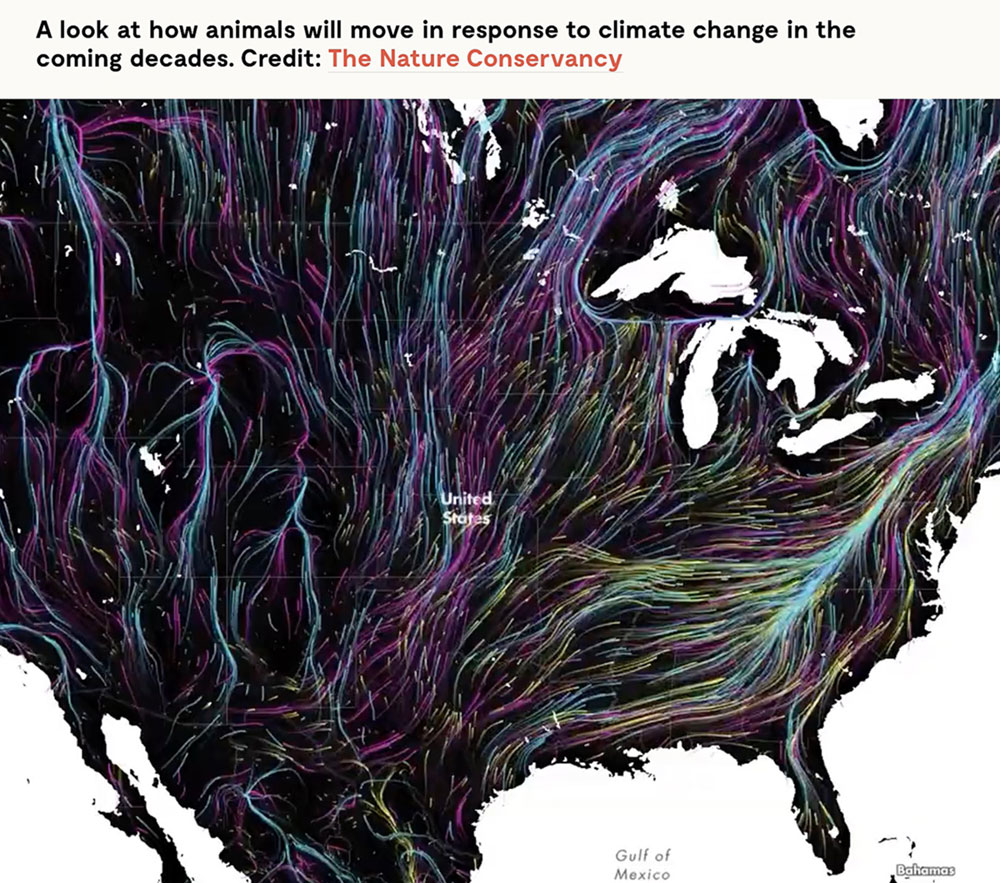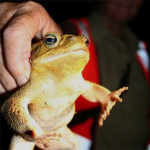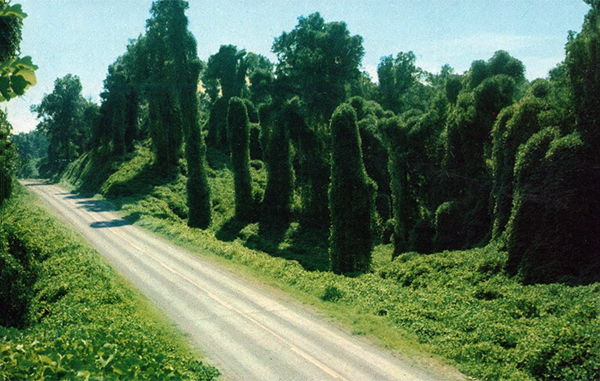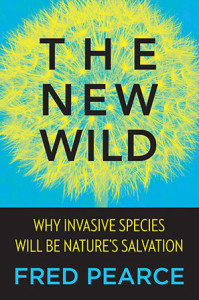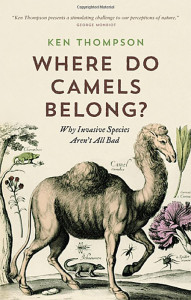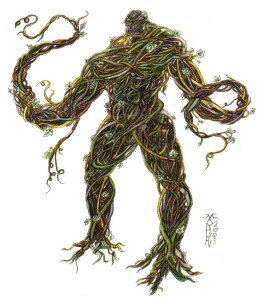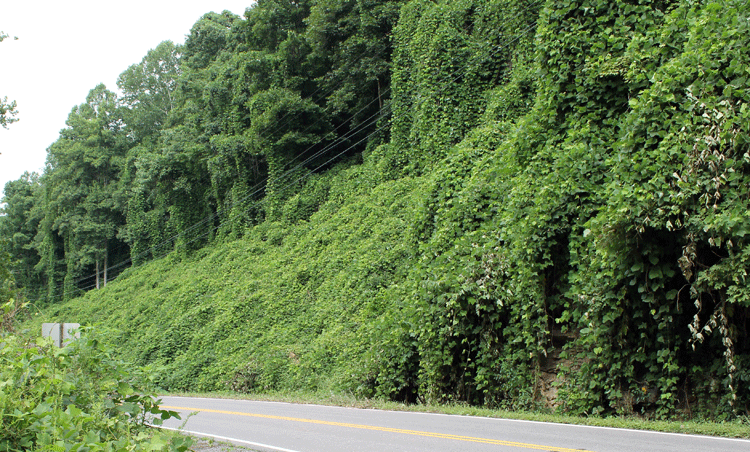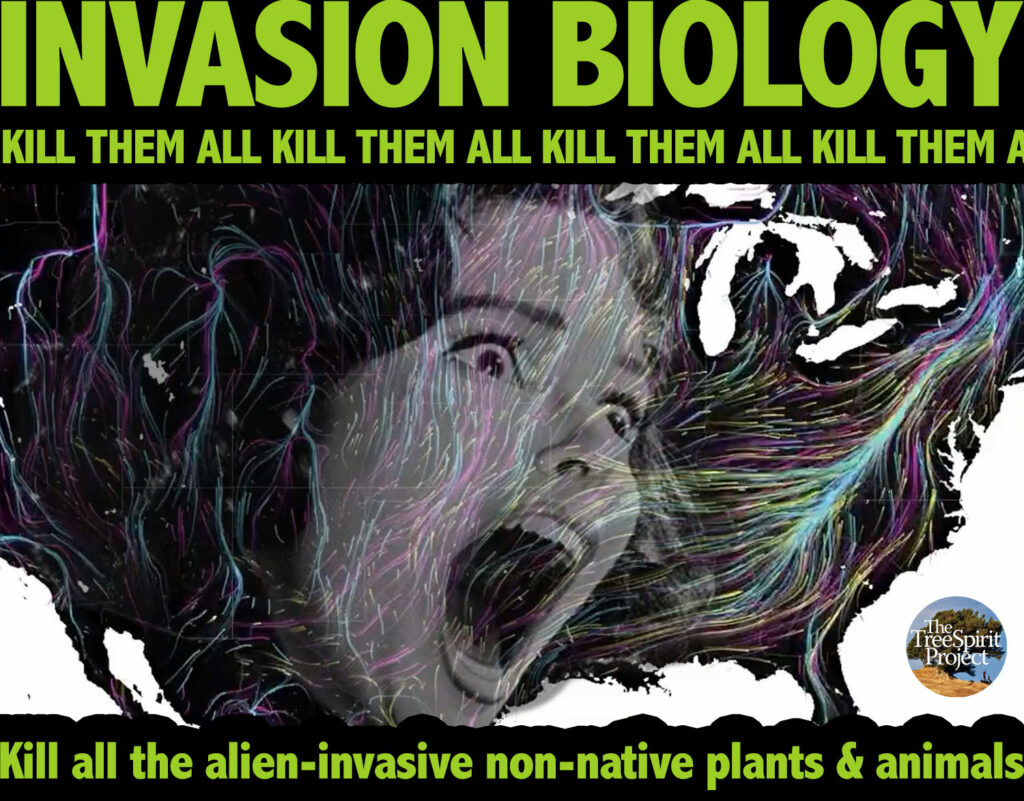
What is Invasion Biology?
Invasion Biology is a term used by a new generation of scientists, researchers, conservation biologists, ecologists and critical thinkers to describe the large, complex biological and ecological field of studies of animal and plant species migrations and interactions.
This includes the broad, tangle of divisively vague, unsubstantiated, pseudo-scientific and non-scientific claims with terminology including “alien,” “native,” “non-native,” “noxious,” “weeds” and “invasive” species.
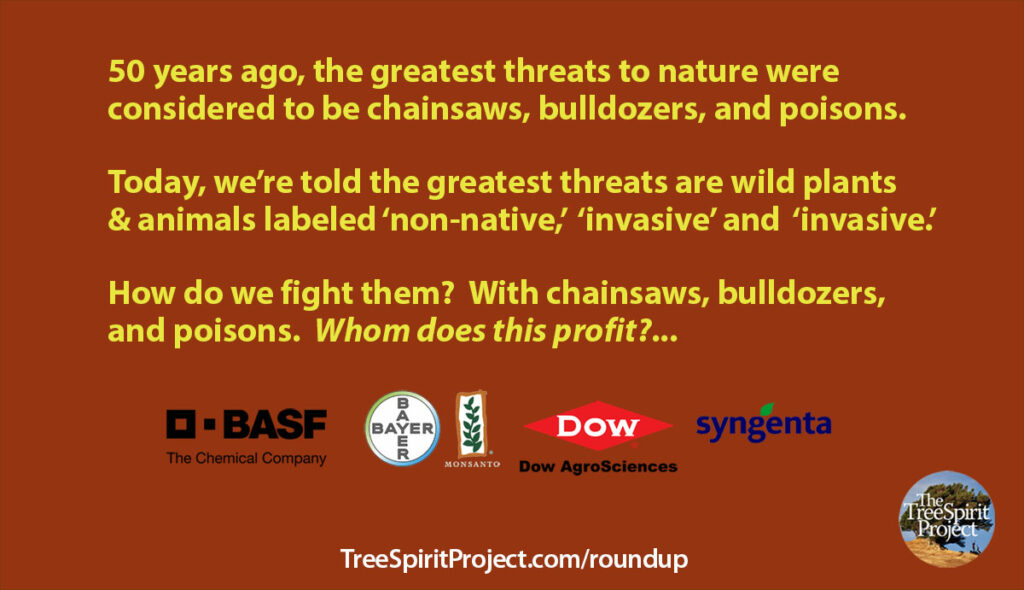
A mish-mash of non-science terms
The terms “invasive” and “non-native” are often used interchangeably by the lay public and media outlets — and even many conservation and restoration workers. This is problematic because this:
1) Falsely implies that all or most “non-native” species are “invasive, when in reality only about 1 in 100 might cause some negative ecological impacts;”
2) Falsely implies that all or most “invasions” are harmful — and thus must be contained, controlled, stopped or killed;
3) Falsely implies that all or most “native” species cause less or no environmental or economic harm than “non-natives”;
4) Falsely implies that so-called “non-native” species (or exotic, alien or imported species) provide little or no ecological benefits;
5) Excludes hundreds of “non-native” plants, including massive Big Ag mono-crops from being categorized, or their impacts on wildlands considered at all;
6) Falsely implies that many or most “non-natives” should be killed by various methods: pulling by hand, chainsaws, bulldozers, and, most commonly used, millions of dollars of toxic biocide chemicals.
7) Ignores the potential small or massive damage the eradication methods themselves can wreak on the environment.
8) Ignores the ecological and scientific reality that plant and animal species are often on the move; that migrations themselves are part of nature’s method for adaption and survival.
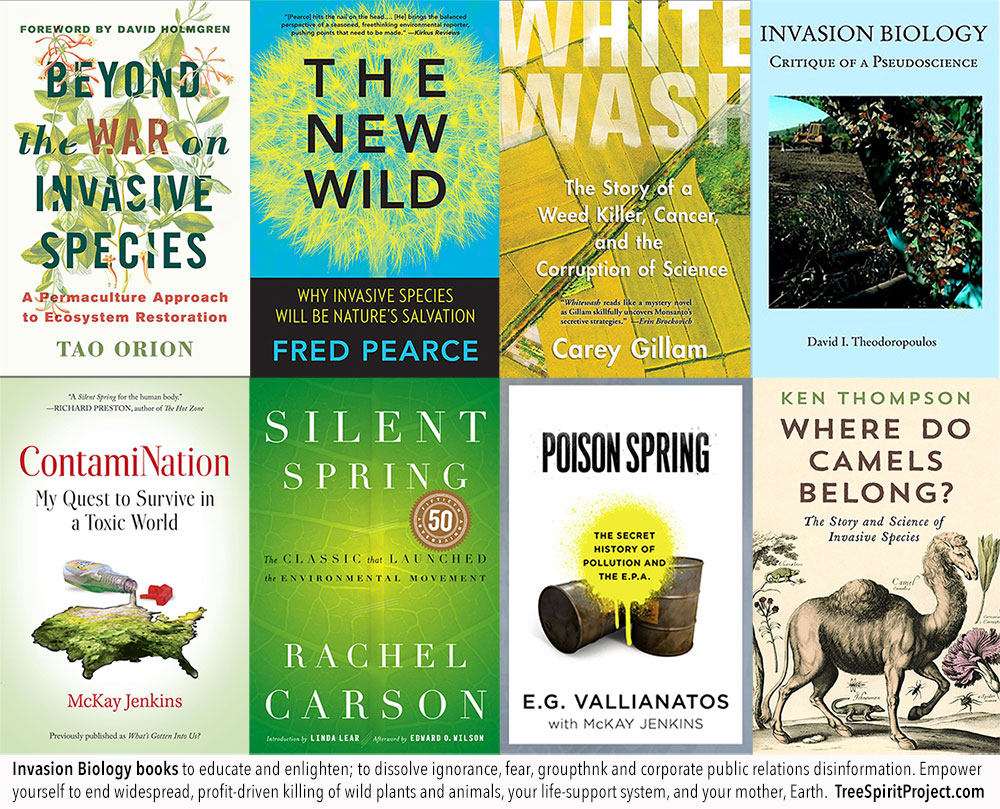
One notorious example of a toxic chemicals extermination program in California is directed at literally millions of eucalyptus (globuslus) trees, a widespread belief — but lacking scientific validity.
The false narrative vilifying Eucalyptus trees can be condensed and summarized:
We have to kill all the invasive, non-native eucalyptus trees in California because they’re crowding out the good, native trees, poisoning the soil, taking all the water that should go to better, “native” plants, and are not habitable by “native” animals.
And eucalyptus are also dangerously flammable — they explode in a fire — like they did back 1991, causing the Oakland, CA hills fire!
And you may as well add: Aiyeeeeee!!!!
None of this is true. None of it is based in science. Yet all of it is widely believed.
LITTLE OF THE “invasive species” FEAR-MONGERING IS SCIENCE-BASED. Scientific DATA, RESEARCH and FACTS supporting these exaggerated claims that Eucalypts — or for that matter any tree species — does environmental harm are few and far between.
So what’s going on here? What motivates all the terror-inducing rhetoric? Thankfully, many new authors are weighing in on this critical, currently hot topic involving so-called “native” and “invasive” species.
 Native Species or Invasive? The Distinction Blurs as the World Warms
Native Species or Invasive? The Distinction Blurs as the World Warms
by Sonia Shah | January 14, 2020
With thousands of species on the move as the climate changes, a growing number of scientists say that the dichotomy between native and alien species has become an outdated concept and that efforts must be made to help migrating species adapt to their new habitats.
EXCERPTS:
The coming exodus, Scheffers and other scientists say, will require a transformation in the way we think about wildlife management and conservation — and a reevaluation of the traditional native-alien dichotomy that has governed it.
For decades, conservation biology has characterized the movement of species into new habitats as potential invasions of alien species with the capacity to threaten local ecosystems and already resident species, leading to the formulation of policies to reflexively repel the newcomers. This approach, and its underlying classification of wild species as either “native” (and thus worthy of protections) or “alien” (and thus likely not) has been the subject of growing controversy in recent years.
Critics such as author Emma Marris and Macalester College biologist Mark Davis, among others, have pointed out that only a small subset of “alien” species wreak damage on already resident species, and that the categorization of wild creatures as either “native” or “alien” obscures as much as it elucidates.
Now, a growing number of scientists say that conservation policies based on the native-alien dichotomy could actually threaten biodiversity. Today’s climate-driven range shifts are “one of the only solutions for species to adapt to climate change,” says ecologist Nathalie Pettorelli, who studies the impact of global environmental changes on biodiversity at the Institute of Zoology in London.
READ Yale Environment 360 ARTICLE: https://e360.yale.edu/features/native-species-or-invasive-the-distinction-blurs-as-the-world-warms
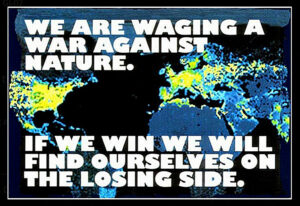
“Modern man talks of a battle with nature, forgetting that if he ever won the battle he would find himself on the losing side.”
– E.F. Schumacher (1911-1977), statistician, economist, Chief Economic Advisor to the UK National Coal Board)
WATCH French broom VIDEO (2 min.)
French broom is a lovely plant in the pea family, and a common target of “nativists” who want to kill thousands of acres of it in California.
“Nativists” routinely kill this hardy, helpful, fast-growing plant, ignoring its prodigious ecological services, which include producing oxygen (O2), sequestering carbon (CO2), stabilizing soil on hillsides, creating animal habitat, fixing soil nitrogen, and even beautifying landscapes of all kinds with pretty yellow flowers — which attract pollinating bees.
All of these numerous ecological benefits — just like most plants provide — are simply dismissed or ignored by “nativists” because they can only see an “invader” who is displacing the “good” (“native”) plants, and thus must be destroyed.
“Invasion Biology” is a common name for this ideology which labels plant and animal species “native” and “non-native,” belonging” or “invasive” — and, like the Old Testament, “Good” and “Bad.” These entirely non-scientific terms are then acted upon with Biblical vengeance — meaning, killing the Bad plants (or animals) by any means, particularly with poisonous herbicides (to kill plants), to protect the supposed Good “natives.” Environmental slaughter in an already dire era of global warming, wreaked upon… dwindling wild plants and animals.
WATCH Jack’s Invasion Biology talk:
TreeSpirit’s Jack Gescheidt talks all about the ideology of Invasion Biology, which has good people running around the wild on plant-killing (and animal-killing) sprees. Hosted by In Defense of Animals Campaigns Director, Lisa Levinson. Q&A with the audience toward the end. October 2023.
Learn why that not only sounds insane, but also lacks scientific validation. The common justification for all the plant killing — euphemistically called “restorations” — is to “protect” biodiversity, to prevent other so-called “native” plants from being “crowded out” and driven to extinction… but such occurrences are rare. In the vast majority of cases, plant migrations increase, not reduce, biodiversity. This is the nature of Mother Nature, in stark contrast the nature of Man-kind which is about killing and control.
Invasion Biology is responsible for a de facto War on Nature in which chainsaws, bulldozers, helicopters — and millions of gallons of toxic pesticides to kill animals and herbicides to kill plants. WHY? In short, because giant chemical companies literally make BILLIONS of dollars selling their poisons, and invest millions back into ongoing public relations campaigns to convince people all this is necessary, even beneficial. Multinationals like Monsanto (now owned by Bayer), Dow, Syngenta, Dupont, BASF, Cargill and more. They have expanded their markets for poisons beyond farms and agricultural crops, into the burgeoning business of killing so-tarred “invasive” “non-native” species on wildlands.
The real threat is not wild plants and animals, but the ideology itself, having spread even into venerable environmental groups that should know better, including the Audubon Society, Nature Conservancy, and Sierra Club — all groups which have adopted the language of war, using terms like “invasions” and “killing.”
Read disturbing Sierra Club example, “When Aliens Attack.” Tragically, the PR campaigns of the chemical giants have done their damage, and A War on Nature is currently raging — and profiting the chemical companies who sell their poisons as weapons to kill wildlife.
Respected author and UC Berkeley journalism professor Michael Pollan covered the topic in 1994, over 20 years ago:
![]() • “Against Nativism” by Michael Pollan, The New York Times Magazine, May 15, 1994: http://michaelpollan.com/articles-archive/against-nativism
• “Against Nativism” by Michael Pollan, The New York Times Magazine, May 15, 1994: http://michaelpollan.com/articles-archive/against-nativism
EXCERPT: The current attack on alien species usually proceeds by citing a few notorious examples of imported plants that have indeed behaved badly on our shores, kudzu being the all-time favorite, closely followed by Japanese honeysuckle, multiflora rose and purple loosestrife. Branded as “huns,” “invaders” or “monsters,” these demon species are then used to tar the entire class of alien plants with guilt by association.
But just how representative are kudzu and its noxious cronies? In fact, the great majority of introduced species can’t even survive beyond the garden wall, much less thrive. And many of the species that have been successfully naturalized we now regard as unobjectionable, even welcome, figures in the landscape. It’s hard to imagine a New England roadside without its tawny day lilies and Queen Anne’s lace, yet both these species are aliens marked for elimination by some of the more zealous natural gardeners. Could it be these plants have actually improved the New England landscape, adding to its diversity and beauty? Shouldn’t there be a statute of limitations on their alien status?
READ FULL ESSAY: http://michaelpollan.com/articles-archive/against-nativism
 • “Weed Whackers: Monsanto, glyphosate, and the war on invasive species” by Andrew Cockburn, Harper’s Magazine, Sept. 2015: http://harpers.org/archive/2015/09/weed-whackers:
• “Weed Whackers: Monsanto, glyphosate, and the war on invasive species” by Andrew Cockburn, Harper’s Magazine, Sept. 2015: http://harpers.org/archive/2015/09/weed-whackers:
EXCERPT: Last year, the federal government spent more than $2 billion to fight the alien invasion, up to half of which was budgeted for glyphosate [Monsanto Roundup™) and other poisons.
 • “Alien Invasion? An Ecologist [Mark Davis] Doubts the Impact of Exotic Species” by Brendan Borrell, Scientific American, Aug. 2014:
• “Alien Invasion? An Ecologist [Mark Davis] Doubts the Impact of Exotic Species” by Brendan Borrell, Scientific American, Aug. 2014:
https://www.scientificamerican.com/article/alien-invasion-ecologist-doubts-exotic
“INVASIONS” debunked in articles from around the world
“Japanese Knotweed has gained a fearsome reputation as an invincible and destructive weed that can threaten the value of properties within its reach. New research from a team of ecologists at Leeds University suggests its destructive capacity may have been exaggerated.”
READ Nov. 15, 2019 ARTICLE: https://www.foxtons.co.uk/discover/2018/11/japanese-knotweed-latest-findings-mild-threat-or-wild-menace.html
READ July 7, 2018 ARTICLE: https://www.leeds.ac.uk/news/article/4262/japanese_knotweed-not_such_a_knotty_problem
EXCERPT: The more I investigate, the more I recognize that kudzu’s place in the popular imagination reveals as much about the power of American myth-making, and the distorted way we see the natural world, as it does about the vine’s [supposed] threat…
In the last few years, a slew of paradigm-challenging new books about so-called “invasive species” have been written.
The latest (April 2015) is, “The New Wild: Why Invasive Species Will Be Nature’s Salvation” by veteran environmental journalist Fred Pearce. Published by Beacon Broadside, “The New Wild” questions “nativist” dogma in many rigorous, objective, analytical, and scientific ways, challenging our unconscious, accumulated assumptions which become society’s accepted, popular beliefs — even if they aren’t true or substantiated.
For example, perhaps you, like me, heard that eucalyptus trees in California, brought to the U.S. from Australia and Tasmania in the 1800s, were harmful, invasive, non-native species. They are often called “dangerous” for being “highly flammable,” and this justifies their eradication, like weeding a garden. If you hear these claims from numerous people and in the news media, for years, it’s natural to assume they must be true, or at least partly true.
Nativist beliefs and ideology are so pervasive they become perceived as true by many people with littler or no proof. The beliefs about eucalyptus trees are reinforced by stirring xenophobic fears of “alien” trees catching fire, being “dangerous,” being “highly flammable,” and so on. You gotta hand it to the public relations wiz who came up with this one: “gasoline trees,” a term applied to eucalyptus trees which number literally in the millions in California. Imagine, making people afraid of…trees. Trouble is if a person hears these labels repeated enough, they become truth — even without substantiation, without any scientific studies to support the drastic claim that any tree species could be so dangerous even while no one is citing numerous eucalyptus tree fires to provide even empirical substantiation.
What you may NOT have heard is this: Poisoning wild plants and animals is today a billion dollar industry. Like all such giant U.S. industries, it has massive public relations, advertising and lobbying forces to influence politicians, governmental agencies, public perception — and public policy. READ MORE.
Monsanto alone sold over $1 billion of glyphosate (in Roundup™) to the U.S. government in 2014. Millions of gallons of this poison, now the world’s most popular herbicide, Monsanto’s Roundup™, and others like Dow Chemical’s Garlon™, are applied to crops, field, tree stumps (including eucalyptus stumps) to poison them and prevent re-sprouting back into trees.
In March, 2015, The World Health Organization classified glyphosate — the active ingredient in Monsanto Roundup™ — a “probably carcinogenic to humans.” – READ Reuters REPORT
 READ MORE about Monsanto Roundup™ toxicity on the rootin’ tootin’ Monsanto Roundup™ PAGE
READ MORE about Monsanto Roundup™ toxicity on the rootin’ tootin’ Monsanto Roundup™ PAGE
AMAZON reviews of “The New Wild”:
The author does a great job providing examples of both good and bad invasive plants and animals. He also dares to tackle the “science” behind some of the popular quotes which get tossed around with minimal scrutiny and perhaps most telling of all…gives the reader a glance into the absolute atrocities perpetuated on nature in the name of wiping out invasives. All in all, a very well written book that is both accessible and informative. – AmazonJavaJunki, 3.16.15
I particularly appreciated his discussions of what really defines a “native species,” especially when placed in opposition to those seen as alien or invasive. Why are tomatoes or potatoes “native plants” in the US when we know the history of their importing? What about birds that fly in and establish, on their own, colonies on islands where they had not existed for eons? How many generations does it take for them to become “native?” – H. Laack, 4.8.15
The key question: ARE these accusations, with staggering ecological ramifications true? Are they science or fact-based?
READ FASCINATING Q&A with veteran environmental journalist author, Fred Pearce: http://www.beaconbroadside.com/broadside/2015/04/embracing-invasive-species-a-qa-with-fred-pearce.html
EXCERPT (emphasis added with bolded text):
Author Fred Pearce: Invasive species are often said to be the second most important threat to nature, after habitat destruction. And for a long time I accepted that claim. As a journalist, I have written plenty of stories about various “alien threats,” from zebra mussels and kudzu to water hyacinth and snakeheads. But I also like to question environmental assumptions. And when I delved into the world of invasive species, I found that—unlike, for instance, the warnings of climate change—there was little evidence to back up the fears. I saw little evidence that there was anything intrinsically bad about invader species. Their downside is often hopelessly hyped; and their potential benefits, such as increasing local biodiversity, are almost never researched.
Environmentalists often condemn migrant species out of hand in the same way that some people condemn migrant humans—and using much the same toxic language. This is lazy thinking. And wrong. The more I looked into it, the more it seemed to me that invasive species might be just the boost that ecosystems messed up by humans often needed. They are often the go-getters, the can-do species that revitalize and reboot nature. They are pretty much the only way nature will cope with climate change, for instance. So demonizing and exterminating them wherever they appear seems like a bad idea.
It turned out I was not alone. I found plenty of “new ecologists” who take the same view…
• “NATIVES vs. EXOTICS: THE MYTH OF THE MENACE: Non-Native Species as Allies of Diversity” Essay by David Theodoropoulus (under pen name, J.L. Hudson)
READ FULL ESSAY: http://www.jlhudsonseeds.net/NativesVsExotics.htm
EXCERPT: “There is an idea, popular in some circles, that ‘non-native’ species are somehow harmful, that ‘aggressive exotics’ can invade ecosystems and destroy ‘native species’. It surprises me to see the public and biologists alike uncritically accept this absurd notion.
EXCERPT: “there is absolutely no biological validity to the concepts of ‘native’ and ‘exotic’ species, nor is there evidence that man’s introduction of species into new habitats has any negative impact on global biological diversity. On the contrary, the aid we have given species in their movement around the world has served to increase both global and local diversity. It is one of the few human activities which is beneficial to the non-human creation. It cannot be distinguished from the movement of species by wind or ocean currents, or the aid other species give to their fellows, such as the distribution of seeds by migrating birds.
– David Theodoropoulus (under pen name, J.L. Hudson)
ANOTHER NEW BOOK CHALLENGING Invasion Biology DOGMA, “Where Do Camels Belong?,” by plant biologist Ken Thompson.
Two reviews:
So often, discussions of the whole issue of natives and non-natives (plants, animals, insects and the rest) are run through with the repetition of bold assertions, unproven by science, that it’s a relief to find a book in which the whole issue is viewed more calmly, in a broad context, considered over time, and backed by solid science. It’s just what we need: more unbiased science and less thoughtless hysteria – and that is what this book provides. And it’s all presented in a lively, and very readable. Ken Thompson discusses how we define “native” and how we stretch our objective definitions to take account of subjective impulses; he reveals how little we actually know about so many non-native species and how very few ever cause problems; he examines whether the most hated invasive species really are as destructive as we’re told and points out that some have positive impacts; he discusses how natives and non-natives can happily co-exist in the same habitat; he applies science to the myths surrounding invasive species. One of the striking features of the response to the presence of non-native plants, in North America in particular, is the frequency with which they’re simply removed – just in case – rather than studied. As Dr Thompson points out, the proportion of non-natives that arrive in natural habitats and end up causing problems is minute. And when non-natives are studied over the long term, we sometimes find that their initial dominance is followed by a sharp decline followed by a stable balance.I won’t steal the author’s thunder by summarizing his invaluable discussion of how we define the word “native”, except to say that picking any date as a cut-off point after which an arriving species is declared an alien is clearly arbitrary and ignores the fact that ecosystems have always evolved over time and continue to do so. And suggesting that only new arrivals in natural habitats that are unassisted by man can be classified as “native” ignores the obvious fact that nowhere on the planet is unaffected by man’s influence, so nowhere is genuinely “natural” anyway.– Graham Rice, Transatlantic Gardener READ FULL REVIEW
Some of the best popular science books are the ones that change your way of looking at something. They might show you, for instance, that time travel is real, not just science fiction, or that quantum theory is not just for Nobel Prize winners – or, in this case, that our whole attitude to invasive species is down to emotional knee-jerk response, not to real science.
Ken Thompson’s fascinating and highly readable book takes us on a tour of the way that ecologists have made invasive species public enemies without any good basis. He shows how it is very difficult to say whether a species is native or alien, and whether this matters. Often, it seems to come down to whether we like the species or not. He shows how many of the invaders we panic about actually improve species diversity, how it’s a perfectly natural thing for species to move from place to place, and how bad science means that ecologists confuse correlation and causality, a classic scientific error.
While turning the view of invasive species on its head, Thompson also keeps us reading with well-crafted and often drily humorous turns of phrase. Describing the brown tree snake (one of the few genuine baddies in these circumstances) and its invasion of the island of Guam, he comments ‘Small, highly gregarious, white eyes [a local bird] roost together on a branch, shoulder to shoulder, and can be taken one at a time without the others taking flight, in a kind of ornithological kebab.’
This is an important and thought provoking book that deserves widespread exposure. At risk of hyperbole, I’d say it is to ecology what Darwin’s Origin of Species was to evolution. Not because it’s as important as Origin, but because like that book, it shows us a piece of biological theory that is entirely obvious and logical once you see it, yet it’s one that most of the people working in the field simply haven’t acknowledged or noticed. Highly recommended.
• READ NY Times article, “Invasive Species Aren’t Always Unwanted“
A growing number of scientists argue that so-called non-native species aren’t categorically bad, may increase not decrease biodiversity, and offer benefits. CLICK HERE
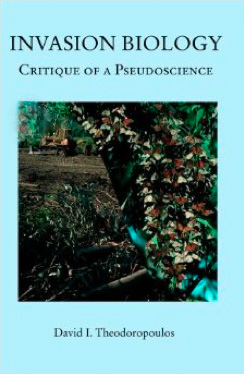 “Invasion Biology: Critique of a Pseudoscience” by David Theodoropoulus is perhaps the book that started it all, questioning the unsubstantiated, tragic assumptions of “native” and “non-native” and “invasivenesss” that has escalated into our current global war on wild plants and animals, armed with pesticides, chainsaws, helicopters, and bulldozers.
“Invasion Biology: Critique of a Pseudoscience” by David Theodoropoulus is perhaps the book that started it all, questioning the unsubstantiated, tragic assumptions of “native” and “non-native” and “invasivenesss” that has escalated into our current global war on wild plants and animals, armed with pesticides, chainsaws, helicopters, and bulldozers.
Theodoropoulos is a conservation biologist who has worked in the fields of ethnobotany and germplasm conservation for 30 years. He has written on scientific ethics, worked with indigenous communities, and currently manages a biological preserve and a public-access seedbank in the Santa Cruz Mountains of California.
More scientists and environmentalists are joining Theodoropoulus in challenging the assumptions, assertions — and lack of science — behind Invasion Biology.
As reviewer Megl Beckman puts it, “…what tales the IBs [Invasion Biologists] tell! It’s easy to be taken in by [their] inflammatory jargon. New species in a region are called “invaders” — never mind that species are constantly moving, even between continents, and such moves are both natural and beneficial. Other derogatory words reinforce the slander: alien, aggressive, dominating, crowding, habitat robbing, monocultural, choking, threats to bio-diversity.
REVIEW: “Another Kind of Genocide,” by Toby Hemenway: http://tobyhemenway.com/201-another-kind-of-genocide
…the author describes the native-plant campaigns of Hitler’s followers, though he is very careful not to call exotics-haters Nazis. He believes invasion biology is rooted in the same fears and prejudices that power Nazism and other racist, genocidal ideologies. A desire for genetic purity and preservation of the homeland, dissatisfaction with current status, an easily identified enemy, and a simplistic answer—extermination—are elements that these ideologies share. And he does call invasion biology an ideology, demonstrating that it cannot justifiably be called a science. In no scientific discipline can data be suppressed or used selectively to support a preconception as is done in invasion biology. Pseudoscience is known for refusing to acknowledge conflicting data, not testing assumptions, exaggeration of limited truths, and circular arguments. (“If it’s not native it’s bad, and the reason it’s bad is because it’s non-native.”) Invasion biology fits this pattern.
Another REVIEW:
… a profound, devastating critique. Well-written and lucid, professionals will appreciate the thoroughness of the citations (I searched in vain for a statement of fact not supported by citation); and the style, while technical, will still be readable by the non-specialist. Sure to be the most controversial book in ecology in a decade. Clear and compelling, this book completely changed my world-view about invasive species. – Luna Verde, Amazon.com reviewer
Another REVIEW:
This is a book of righteous science. The radical environmental movement has launched an entire industry based on bad science, and David Theodoropoulos shines a light on their misdeeds. A few well-placed but unfounded untruths — that the status quo is “good” and change is bad, that existing biota have innate rights to possess the land they are in, and that new interactions between species are morally abhorrent — and the stage is set to have the tale wag the dog.
And what tales the IBs [Invasion Biologists] tell! It’s easy to be taken in by the inflammatory jargon. New species in a region are called “invaders” — never mind that species are constantly moving, even between continents, and such moves are both natural and beneficial. Other derogatory words reinforce the slander: alien, aggressive, dominating, crowding, habitat robbing, monocultural, choking, threats to bio-diversity. It’s not hard to figure out who’s bad side some species ended up on.
Theodoropoulos rightly observes that hot-headed words have no place in real science. Real science uses the scientific method to build upon established precepts, is open to disproof, and welcomes rational argument. IBs label any dissenters as unlearned, unqualified, and obviously maliciously untrustworthy. That is, of course, what the IBs say about Theodoropoulos — he’s not in the invasion biologist’s Who’s Who, so he’s an ignorant rube. No defense of IB is thus required.
He also unmasks the motive behind the invasion biology mentality: plentiful funding for finding threats, mostly unreal and imagined. No funding at all for finding out that everything is A.O.K.
The hubric notion that some species “belong” in certain places just because some self-proclaimed experts say so loses its power once you see behind the curtain. The irony is that IBs acuse Theodoropoulos of being a self-proclaimed expert, while presenting no scientific basis for their own supposed expertise. IBs somehow are able to know just which species belong where, and have the moral compass to steer the rest of us to genocide.
Invasion biology inflates its already self-invented importance by not just claiming that “invasions” are something to guard against, but by screaming that we are in a full-fledged invasion crisis. Crises require immediate action. Now. Kill that plant now. Drain that pond, now! Wipe out that evil, aggressive, choking, unfairly competing, life form NOW, before it multiplies! DO IT NOW! THIS IS A CRISIS FOR PETE’S SAKE!
Theodoropoulos names names and gives details. Purple loosestrife, rather than the desolator of species IBs libel it as, actually befriends more native insects and avians than the official “native” plants. Tamarisk is not a soul sucker, but a savior, increasing rather than decreasing bio diversity. Theodoropoulos gives dozens of other examples, with persuasive documentation and irresistible reasoning.. – Mel Beckman, , Amazon.com reviewer
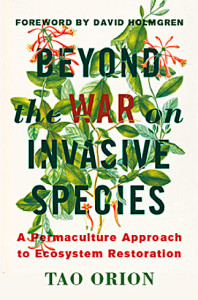 “Beyond the War on Invasive Species: A Permaculture Approach to Ecosystem Restoration” by Tao Orion, a permaculturist with a degree in agroecology from UC Santa Cruz, is yet another new book (July, 2015) offering a sorely needed, radically different perspective on the war on invasive species. [Bolded type in reviews below is added for emphasis by TreeSpirit Project.]
“Beyond the War on Invasive Species: A Permaculture Approach to Ecosystem Restoration” by Tao Orion, a permaculturist with a degree in agroecology from UC Santa Cruz, is yet another new book (July, 2015) offering a sorely needed, radically different perspective on the war on invasive species. [Bolded type in reviews below is added for emphasis by TreeSpirit Project.]
REVIEWS [Bolded type in excerpts below is added for emphasis]:
“This book brings much-needed balance to the overheated debate about so-called invasive species. Tao Orion’s meticulously researched yet engaging work shows that the true culprits are nearly always human-caused disturbance and development, and that species shifts are a symptom, not a cause, of this habitat destruction. “Beyond the War on Invasive Species” is an important book that offers a path away from unsuccessful restoration efforts―based on poor science and policy―and toward new, ecologically sound programs for building and preserving biodiversity.” – Toby Hemenway, author of Gaia’s Garden: A Guide to Home-Scale Permaculture and The Permaculture City: Regenerative Design for Urban, Suburban, and Town Resilience
“…where the arsenal is stocked with bulldozers, chainsaws, and herbicides put to the task of their immediate eradication. In Hawaii, mangrove trees (Avicennia spp.) are sprayed with glyphosate [Monsanto’s Roundup™ – Ed.] and left to decompose on the sandy shorelines where they grow, and in Washington, helicopters apply the herbicide Imazapyr to smooth cordgrass (Spartina alterniflora) growing in estuaries. The “war on invasive species” is in full swing, but given the scope of such potentially dangerous and ecologically degrading eradication practices, it is necessary to question the very nature of the battle.” – excerpt from the publisher’s description
“A gathering body of evidence against the scale of chemical interventions in both agriculture and wild nature is fueling a battle of geopolitical proportions. In the process of asking the questions about how best to restore nature, Orion exposes a deep ethical corruption at the heart of both ecological science and the environmental movement.” – David Holmgren, from the Foreword
 READ INTERVIEW with author Tao Orion by the Organic Consumers Association: https://www.organicconsumers.org/news/interview-tao-orion-author-beyond-war-invasive-species
READ INTERVIEW with author Tao Orion by the Organic Consumers Association: https://www.organicconsumers.org/news/interview-tao-orion-author-beyond-war-invasive-species
 • READ “The Invasive Ideology – Biologists and conservationists are too eager to demonize non-native species” by Matthew K. Chew and Scott P. Carroll – Sept. 7, 2011: http://www.the-scientist.com/?articles.view/articleNo/31143/title/Opinion–The-Invasive-Ideology
• READ “The Invasive Ideology – Biologists and conservationists are too eager to demonize non-native species” by Matthew K. Chew and Scott P. Carroll – Sept. 7, 2011: http://www.the-scientist.com/?articles.view/articleNo/31143/title/Opinion–The-Invasive-Ideology
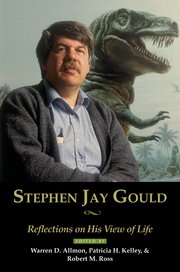 • Harvard evolutionary biologist Stephen Jay Gould’s critique of “native” plants concept: “An Evolutionary Perspective on Strengths, Fallacies, and Confusions in the Concept of Native Plants.”
• Harvard evolutionary biologist Stephen Jay Gould’s critique of “native” plants concept: “An Evolutionary Perspective on Strengths, Fallacies, and Confusions in the Concept of Native Plants.”
EXCERPT: …this notion [of “native plants”] encompasses a remarkable mixture of sound biology, invalid ideas, false extensions, ethical implications, and political usages both intended and unanticipated.
Our minds create beliefs from an accumulation of ideas, as well they should. We don’t create, or discard, a belief from hearing one contradictory fact. But this means if we accept several related ideas as true, especially after hearing them repeated over time — but the ideas are actually NOT true — we may create a belief that isn’t true, yet impervious to any one truth challenging it. This is how racist beliefs and prejudices are formed, and are so fervently defended, and so difficult to challenge.
“Sometimes people hold a core belief that is very strong. When they are presented with evidence that works against that belief, the new evidence cannot be accepted. It would create a feeling that is extremely uncomfortable, called cognitive dissonance. And because it is so important to protect the core belief, they will rationalize, ignore and even deny anything that doesn’t fit in with the core belief.”
– Frantz Fanon, Black Skin, White Masks
If you repeat a lie long enough it becomes real. Then the lie no longer exists and what you’re left with is your version of the truth.
– Irfan Master
WATCH mind-opening presentation dissecting the pseudo-science of so-called “native species,” and challenging popular misconceptions by conservation biologist David Theodoropoulus @ the Public Interest Environmental Law Conference, Eugene, OR, March 5th, 2011:
MORE AUTHORITIES challenge Invasion Biology, building a new concensus: we shouldn’t continue waging war on nature:
![]() • “Don’t Judge Species On Their Origins, ” by Mark Davis, w. 18 other ecologists, Nature Magazine Vol. 474, 6.9.11, READ HERE
• “Don’t Judge Species On Their Origins, ” by Mark Davis, w. 18 other ecologists, Nature Magazine Vol. 474, 6.9.11, READ HERE
EXCERPT: “Over the past few decades, ‘non-native’ species have been vilified for driving beloved ‘native’ species to extinction and generally polluting ‘natural’ environments. Intentionally or not, such characterizations have helped to create a pervasive bias against alien species that has been embraced by the public, conservationists, land managers and policy-makers, as well as by many scientists, throughout the world.”
![]() • “Ecologists: Time to End Invasive-Species Persecution” by Bradon Keim, Wired Magazine, 6.8.11: CLICK HERE
• “Ecologists: Time to End Invasive-Species Persecution” by Bradon Keim, Wired Magazine, 6.8.11: CLICK HERE
EXCERPT: “People like to have an enemy, and vilifying non-native species makes the world very simple,” said ecologist Mark Davis of Macalester College. “The public got sold this nativist paradigm: Native species are the good ones, and non-native species are bad. It’s a 20th century concept, like wilderness, that doesn’t make sense in the 21st century.”
 • “Time to Stop Worrying about Invasive Species?”, podcast by Karen Hopkins, Scientific American, 6.8.11: CLICK HERE
• “Time to Stop Worrying about Invasive Species?”, podcast by Karen Hopkins, Scientific American, 6.8.11: CLICK HERE
EXCERPT:
You shouldn’t judge a book by its cover. And you shouldn’t judge a species by its place of origin. So say ecologists in a commentary in the journal Nature. [Mark Davis et al, Don’t judge species on their origins] They argue that conservationists should assess organisms based on their impact on the local environment, rather than simply whether they’re native.
When you hear the phrase “non-native species” you no doubt conjure up an image of an invasive animal or plant that’s pushing out the native species and wreaking havoc on the local ecology—like zebra mussels in the Great Lakes or cane toads in Australia. But Mark Davis of Macalester College in Minnesota and his colleagues see things differently. They say that being indigenous doesn’t grant a species special rights to inhabit an ecosystem. Or mean that its presence is good for the environment. The insect currently thought to kill more trees than any other in America is the native mountain pine beetle. And many invaders actually boost biodiversity, not decimate it.
As climate change and urbanization continue to reshape the ecological landscape, more species will leave their homelands—making the distinction between resident and alien a moot point. So, ask not where a species comes from. But whether it belongs.
— Karen Hopkin
 • “Alien Species: Not All Bad, and Not Even All Alien,” Huffington Post, August 17, 2015, by Ken Thompson, plant biologist, author of six books on gardening and popular science: CLICK HERE
• “Alien Species: Not All Bad, and Not Even All Alien,” Huffington Post, August 17, 2015, by Ken Thompson, plant biologist, author of six books on gardening and popular science: CLICK HERE
 • “Ending The Toxic, Costly and Unnecessary War On Invasive Plants” by Danielle Prohom Olson, GATHER, Sept. 28, 2015: https://gathervictoria.com/2015/09/28/ending-the-toxic-costly-and-unnecessary-war-on-invasive-plants-who-does-the-war-serve
• “Ending The Toxic, Costly and Unnecessary War On Invasive Plants” by Danielle Prohom Olson, GATHER, Sept. 28, 2015: https://gathervictoria.com/2015/09/28/ending-the-toxic-costly-and-unnecessary-war-on-invasive-plants-who-does-the-war-serve
![]() • Boyce Thorne Miller, science and policy advisor at The Northwest Atlantic Marine Alliance (NAMA), also the author of “The Living Ocean,” speaks about the dangers and futility of pesticides and other methods now commonly used to kill so-called “invasive species.” and questions the definition of “native.”
• Boyce Thorne Miller, science and policy advisor at The Northwest Atlantic Marine Alliance (NAMA), also the author of “The Living Ocean,” speaks about the dangers and futility of pesticides and other methods now commonly used to kill so-called “invasive species.” and questions the definition of “native.”
2nd VIDEO: “Rethinking Invasive Species” at 32nd National Pesticide Forum, Portand State University, Portland, OR. April 11-12, 2014: https://www.youtube.com/watch?v=jY82U4R5sME&feature=youtu.be
![]() • “Is Eucalyptus [an] ecologically hazardous tree species?,” by Tesfaye Teshome, PhD, Wondo Genet College of Forestry, Debub University, Awassa, Ethiopia, AFRICA. Even in Africa, similar claims of eucalypt invasion are made without substantiation — and debunked by scientific research: CLICK HERE
• “Is Eucalyptus [an] ecologically hazardous tree species?,” by Tesfaye Teshome, PhD, Wondo Genet College of Forestry, Debub University, Awassa, Ethiopia, AFRICA. Even in Africa, similar claims of eucalypt invasion are made without substantiation — and debunked by scientific research: CLICK HERE
EXCERPT: Water consumption of eucalyptus — Most people think that eucalyptus consumes a lot of water more than any other tree species and agricultural crop. This misconception is untrue. There are quite a number of research results which revealed that eucalyptus is efficient water user. For instance, Davidson (1989) reported that on a “leakproof hectare” at Nekemet (with annual rainfall of 2158mm), E. saligna and E. grandis could produce 46.6 m3/ha/yr without drawing on water reserves (rainfall only) compared to 16.4, 16, 12.4 m3/ha/yr biomass production for the coniferous, acacia and broadleaf species, respectively. These figures reveal that for the same amount of water consumed eucalyptus produce higher amount of biomass which is economically profitable and acceptable.“
 READ MORE about Monsanto Roundup™ on the rootin’ tootin’ Monsanto Roundup™ PAGE
READ MORE about Monsanto Roundup™ on the rootin’ tootin’ Monsanto Roundup™ PAGE
Cutting through kudzu myths
Contrary to the popular misconception, kudzu, imported to the U.S. decades ago from Asia, is in fact, a beneficial, plant. Similar to the equally maligned the Australian eucalyptus tree. Kudzu was brought to the U.S. to “green” the South and fortify depleted soils — but then got a reputation for being a destructive “invasive” species, despite the usual lack of scientific studies to back the catchy cataclysmic claims which make headlines and promote yet another war on nature… which we are supposed to fight with toxic herbicides… which benefits whom exactly?..
LEARN MORE: The True Story of Kudzu, the Vine That Never Truly Ate the South, by Bill Finch, Smithsonian Magazine, Sept. 2015
People see kudzu growing wildly over everything that’s visible from roadways in the Southeastern U.S., because that’s where the most sunlight is and then assume — mistakenly — kudzu is devouring entire forests that are shaded. READ MORE:

